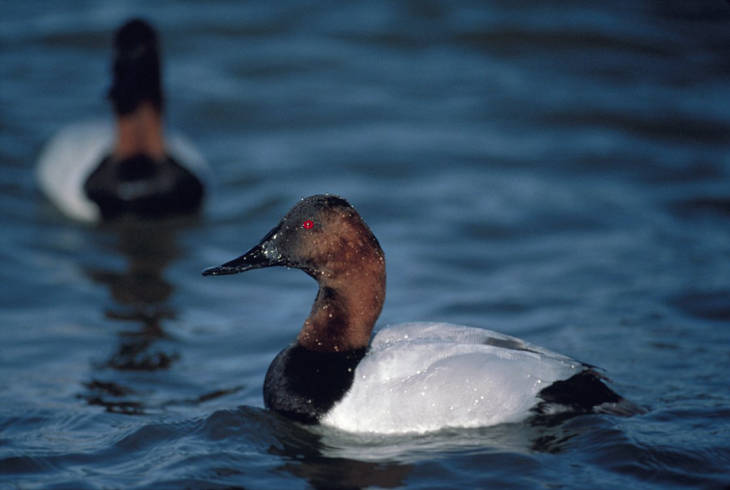The Odd Duck

We’ve always thought that the canvasback was one well-named duck. The male canvasback does indeed look as if it has a piece of new, white canvas draped across its back. The white back provides a gorgeous contrast to its rusty-red head and distinctive long-sloping head profile. And somehow describing the color of the back of a water-loving bird with a word normally used to describe a kind of fabric that is often used in boats, makes it even more fittingly unique.
With a recent sliver of unaccounted-for-time, we followed a lead from posts to the Maine birding listserve to bop over to Damariscotta Mills to see a lone male canvasback that has been hanging around there. In the heart of the species’ wintering range, you can expect to see canvasbacks in flocks. We have wonderful memories of seeing sometimes hundreds of canvasbacks in migration and in winter on Cayuga Lake, one of the long, narrow Finger Lakes, at the south end of which lies the city of Ithaca and Cornell University. Even in mid-winter, it was usually possible to find some canvasbacks in some area of open water on that deep lake or at least at the famous always-open, warm spring-fed pond at the well-named town of Union Springs. That pond could sometimes be crammed with hundreds of ducks of 10 or more species when almost everything else around was frozen solid.
Here in Maine a sighting of a canvasback is an extra special thing. There are perhaps only one or two found every year, and sometimes a year can go by without any seen at all. A few times there have been two seen together and even rarely more than that but most records have been of single birds. Interestingly, a single make canvasback was seen regularly last winter in the Damariscotta River. Maybe this particular bird found the food and accommodations of the area to his liking last year and decided to return again?
Canvasbacks are omnivores and can eat roots and leaves of aquatic plants as well as various small creatures like clams, mussels, crabs, marine worms, and probably lots more. Birds in some areas are even known to eat dried corn. We’ve suspected that someone may throw out corn for the domestic geese and wild mallards that are just about always down in the area between the bridge and railroad tracks at Damariscotta Mills. Maybe that canvasback supplements his diet with a little of that corn, too?
A number of places in Maine have had wintering ring-necked ducks this year, a species that decades ago was almost unheard of here between late December and early February. After enjoying watching the canvasback amidst some snow flurries on our visit, we drove up to the bridge at the upper end of Damariscotta Mills where Damariscotta Lake drains down into Great Salt Bay. This is a favorite place on hot summer days for us and many others to jump off the bridge and swim in the lake. That day, the lake was covered in a layer of immaculate white snow-covered ice but open water was still flowing under the bridge and into the little pond beyond. In that little pond were nine spiffy ring-necked ducks and eight little hooded mergansers.
Enjoying ourselves despite the shivering cold and falling snow, we suddenly wondered if the canvasback and the other ducks had been watching us back, thinking to themselves, “Look at those odd ducks.”
Jeffrey V. Wells, Ph.D., is a Fellow of the Cornell Lab of Ornithology. Dr. Wells is one of the nation's leading bird experts and conservation biologists and author of “Birder’s Conservation Handbook”. His grandfather, the late John Chase, was a columnist for the Boothbay Register for many years. Allison Childs Wells, formerly of the Cornell Lab of Ornithology, is a senior director at the Natural Resources Council of Maine, a nonprofit membership organization working statewide to protect the nature of Maine. Both are widely published natural history writers and are the authors of the book, “Maine’s Favorite Birds” and “Birds of Aruba, Bonaire, and Curaçao: A Site and Field Guide” from Cornell Press.



























